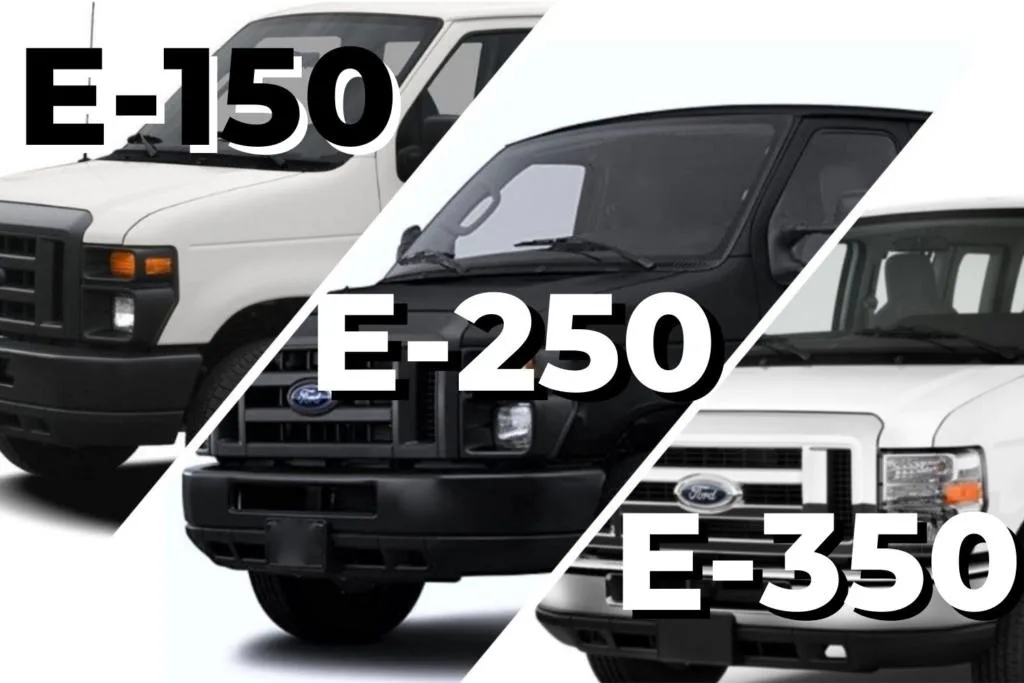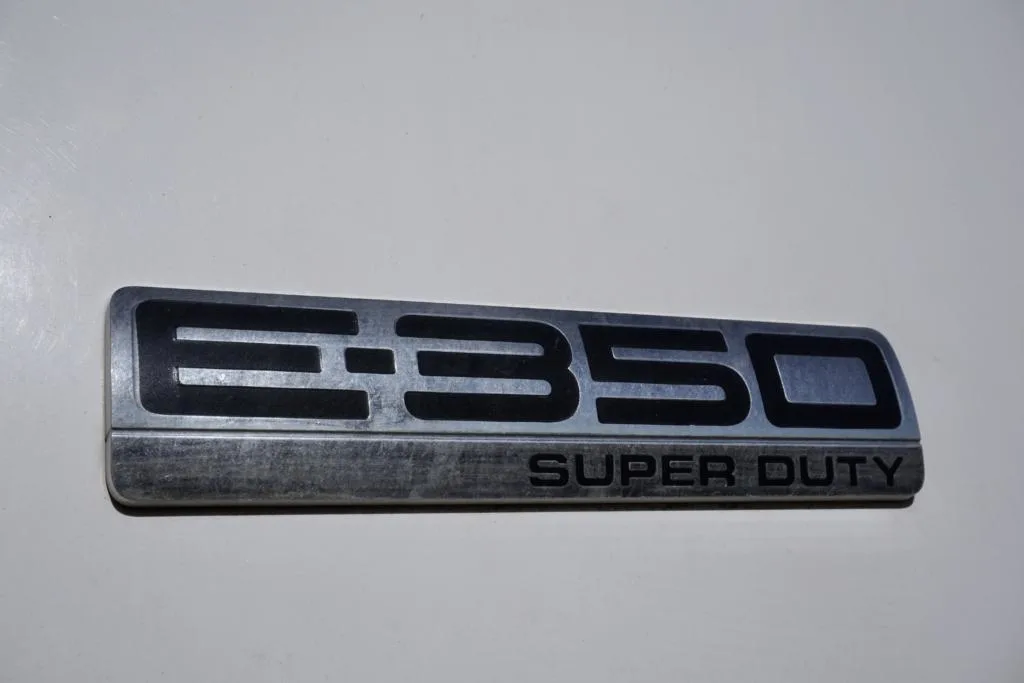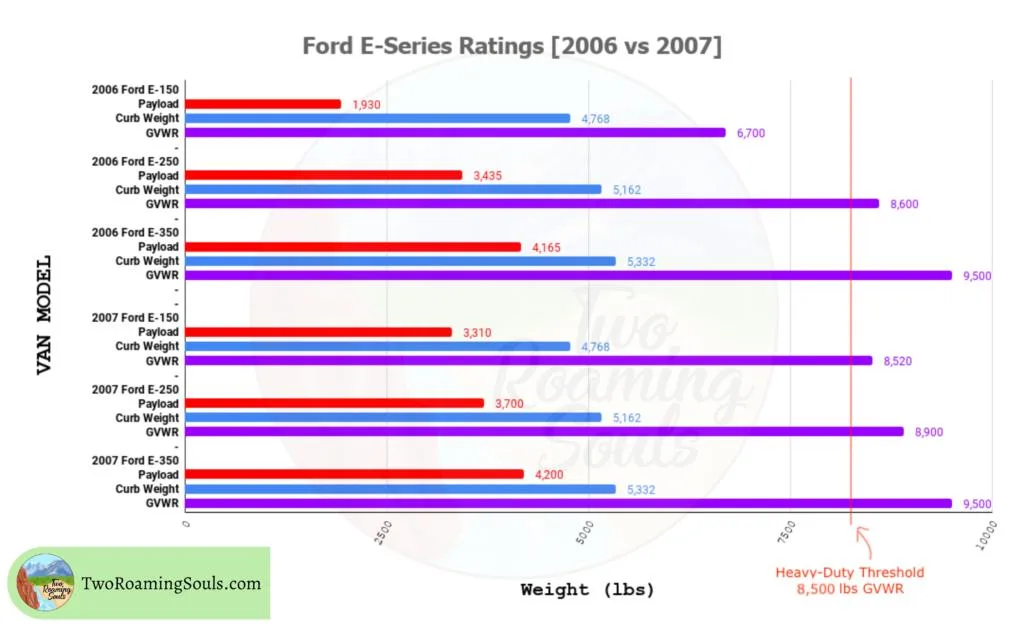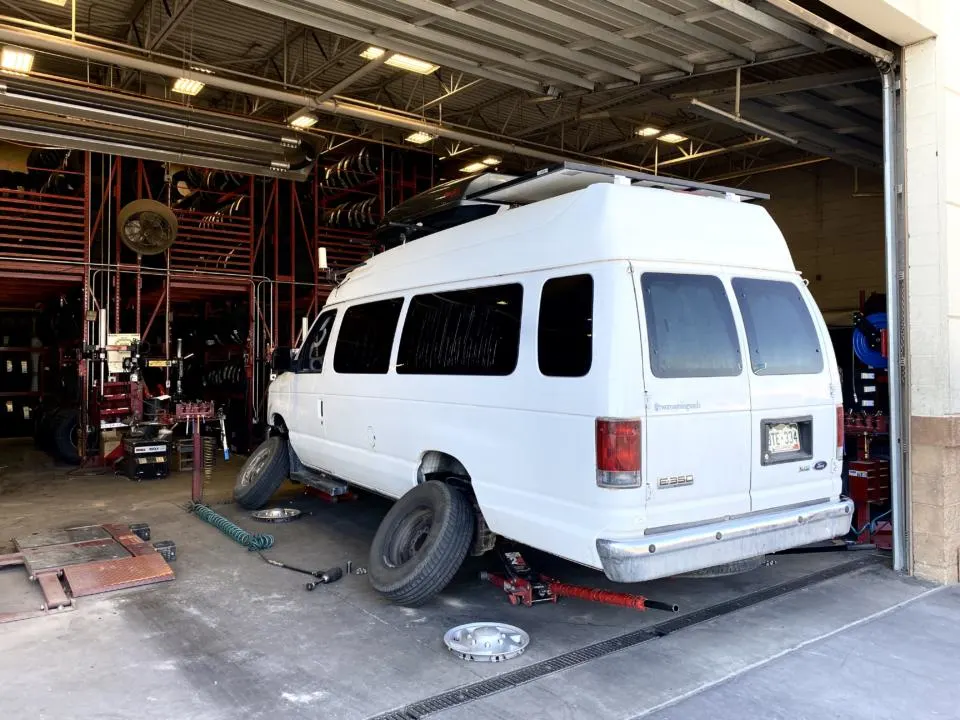
Are you confused about the difference between the different types of Ford E-series vans? What exactly is the difference between Ford E-150, E-250, and E-350 vans? In this post I will explain the difference between these common Ford E-series vans, and why you might choose one over another.
(And if you are curious, the other American vans have a similar relationship. So you can roughly apply the same explanation to Chevy Express and GMC Savana 1500, 2500, 3500).
Check out my post that covers all types of vans: How To Choose A Van For A Campervan Conversion.
The Basic Difference
In easy to understand terms, the higher the number, the more heavy-duty the van is and the more weight it can haul. And it means the vans are built with different parts to accommodate more weight (i.e. bigger engines, more robust suspension/brakes/etc.
Or if you’re familiar with Ford Trucks, it’s a similar relationship between Ford F-150, F-250, and F-350. After all, these Ford vans are heavily based on their truck platforms.
What is Econoline?
Econoline is the former name of the Ford E-Series vans. Aside from updates throughout the years, they are the same line of vehicles. The Econoline and E-Series vans have been in production since 1961. However, after 2014 it was discontinued in passenger and cargo models. The only models available from 2015-Present are the stripped chassis or cutaway chassis models.
Terms To Know
Curb Weight – How much a vehicle weighs without passengers or cargo.
GVWR – Stands for Gross Vehicle Weight Rating, and it’s the maximum weight that a vehicle can reach including passengers, cargo, gasoline, fluids.
Payload – How much weight in cargo and/or passengers a vehicle can carry. You subtract GVWR – Curb Weight = Payload.
What Does The Number Signify?

The number in the name of each van indicates their increasing payload (how much weight it can haul).
There are two main classifications that help group similar vehicles.
The first is how the government classifies vehicles (for fuel efficiency). They classify Light-Duty as any vehicle with up to 8500lbs GVWR or up to 4000lbs payload. The Ford E-250 and E-350 are both above that threshold, and thus classified as heavy-duty. The Ford E-150 was light-duty up until 2006 when it surpassed the 8500lbs GVWR threshold, and joined the other vans as a heavy-duty classification.
The second common shorthand way to classify vans is by referring to their payload in terms of tons {one ton = 2000lbs}. So the E-150 is ½ ton, E-250 is a ¾ ton, and E-350 is a one ton. But this system is wildly outdated because the payload ratings have soared past those definitions. For example, the “one ton” 2014 Ford E-350 has a payload of 4,060lbs, which is literally two tons! And yet, people still use these antiquated terms.
How Are They Built Different?
In order to haul more weight, each increasing van has certain parts upgraded to accommodate a higher payload. The E-250’s and E-350’s are built with more robust suspension, brakes, etc. They may also have larger engines, better transmissions, and a higher output alternator. These changes results in a higher curb-weight but ultimately the ability to haul more stuff.
Payload Comparison
It’s important to choose a van with an appropriate payload rating for your intended use. As I stated above, the E-350 has the highest payload, followed by E-250, and finally E-150 at the bottom. And generally payloads and towing capacity have increased over time as the technology improves.
But there is one massive outlier, outside the normal incremental changes. Between 2006 and 2007 the E-150 saw a drastic payload increase. This increase resulted in the E-150 switching classification from “light-duty” to join the E250 and E350 as a “heavy-duty” vehicle. That change is illustrated below.

How they managed to increase the payload by over 1000 lbs without increasing the curb-weight is rather surprising (or concerning). I wonder if these post 2007 E-150’s are really built to handle those loads, or if they will break down faster.
Why Did Ford Phase Out The “Light-Duty” E-150
Ford intentionally got rid of the light-duty E-150 because EPA regulations for fuel efficiency were becoming increasingly harder to achieve with light-duty vans. They did this by boosting the GVWR over 8,400lbs to force reclassification as heavy-duty.
This EPA fuel-efficiency pressure has driven most companies to bail on their light-duty vans (Chevy got rid of the Express 1500 in 2014). By 2020, most automakers have created a wide gap between their heavy-duty full-size vans and their small city-oriented light-duty vans (like Ford Transit Connect and RAM Promaster City)
Towing Capacity
The Ford E-350 is, as expected, the strongest in the towing category. However, somewhat counterintuitively, the E-250 has less towing capacity than E-150.
Length & Wheelbase
All E-Series vans have a 138” wheelbase (distance between front and rear axle). However there are Extended versions available for E250 and E350.
Cargo Vs. Passenger (Wagon)
You will see these vans offered in cargo or wagon models. Basically, the cargo vans are work vans that are just an empty metal shell in the back. There are usually only windows on the back doors.
The wagon models (aka passenger) are meant for carrying people. They will have seats, windows on all sides, a finished interior, and possibly climate control, lights, charge ports, speakers, etc.
What Does XL and XLT Stand For?
XL and XLT don’t have anything to do with the length or size of the van, unlike many people assume. These titles stand for the different trim offerings. XL and XLT are generally reserved for the passenger (wagon) models because they include extra features that make the van more comfortable for passengers. It can include rear air-conditioning, satellite radio, nicer upholstery, ABS and more.
That’s pretty much the end of the easily quantifiable differences. But smart buyers will still wonder how these different models compare in categories with larger variance, such as Fuel Economy, Cost of Ownership, and Longevity.
I’ve spent hours researching the more nuanced differences between E-Series vans. The problem is that finding concrete evidence to support claims is difficult because the real-world doesn’t function like some perfectly controlled science experiment.
- The manufacturers and dealers claims are sometimes not consistent with the real-world numbers.
- Or you can turn to automotive websites {like Edmunds.com, Autoblog.com, etc} who either regurgitate the manufacturers’ claims, or try (and possibly fail) to make predictions about real-world MPG, Cost of Ownership, etc.
- And lastly, you have just regular people on forums and blogs providing their own anecdotal “evidence” to support their claims. And obviously, that method is subject to error.
So I’ve done my best to summarize the things that are generally accepted as true. That is, multiple sources confirm roughly the same information.
But one huge piece of advice that I hear echoed over and over from fleet owners and mechanics is this:
How you treat your van is much more important than which one you have. Any marginal difference in fuel economy, repair costs, and longevity can be obliterated by poor ownership.
Fuel Economy
The fuel economy generally gets worse with each increasing model. But the difference between Ford E-150, E-250, and E-350 is only a few MPG.
And this of course depends on how you use the van. Because an overloaded E-150 may get worse MPG than an E-350 working comfortably within it’s GVWR.
Ride Comfort
The fact that these vans are tuned for specific payloads, means that they ride smoother when loaded properly. So an empty E-350 is going to be a really rough ride. Conversely, an overloaded E-150 will also be rough, because the suspension is bottoming out. If you drive the van empty occasionally, then the E-150 and E-250 are better tuned for alternating between loaded and un-loaded.
Repairs and Maintenance

The repairs and maintenance will on average cost more for each increasing model.
Longevity
A WELL-MAINTAINED E-Series van should last until 250-300k miles on the original engine. And the transmission usually bites the dust around 150-250k miles.
As far as the difference between Ford E-150, E-250 and E-350 vans, I’ve only seen anecdotal claims that the 250’s and 350’s vans last longer. But it’s hard to find concrete evidence of this in the real world. It may be that E-150 owners are just overloading their vans, so they don’t last as long.
Conclusion: Which Van Should you Choose?
The primary factor when choosing from the E-Series lineup is Payload and Towing, since that is the main quantifiable difference between Ford E-150, E-250, and E-350. At the end of the day, you need a van capable of handling the weight you need to move. But equally important is finding a van that’s in good mechanical shape.
In the context of campervan conversions, the weight of your conversion materials will dictate the payload required. This will depend on what type of conversion you’re planning. A general rule of thumb is that E-250 and 350 are best for elaborate conversions for 2 or more people with wooden furniture, water tanks, batteries, and all your belongings. The E-150 is better suited for builds with lightweight materials (plastic, foam, aluminum) or “weekend-warrior” type conversions that aren’t loaded with so many personal belongings.
If you plan on towing, then E-350 can tow the most. But just remember the caveat that E-150 has more towing than the E-250. However, unless you’re towing something like a large boat or camper trailer, then any E-Series will do the job.
If you must have an Extended van, then you are limited to the E-250 and E-350.

How Much Water Does A Campervan Need For Vanlife - tworoamingsouls
Friday 7th of April 2023
[…] What’s the difference between Ford E-150, E-250, and E-350 vans? […]
How To Choose A Van For A Campervan Conversion - tworoamingsouls
Wednesday 5th of April 2023
[…] example: Ford E-350 can carry more than Ford E-250, which can carry more than Ford E-150 (Complete guide to Ford E-Series Vans). And most other full-size vans have a similar system (i.e. Chevy Express 1500, 2500, & […]
What’s The Difference Between Ford E-150, E-250, And E-350? – Hivan
Friday 13th of May 2022
[…] to Two Roaming Souls, the Ford E250’s payload is 3,600, which isn’t much more than the E150. However, having the […]
All Vans With 4x4 or AWD (in the US) - tworoamingsouls
Monday 7th of March 2022
[…] you can sometimes find a used 4×4 van that someone else converted. Ford E-series vans are the most common vans to have an aftermarket 4×4 […]
What's The Difference Between Chevy Express 1500, 2500, and 3500 Vans. - tworoamingsouls
Sunday 17th of January 2021
[…] other American vans have a similar relationship. So you can roughly apply the same explanation to Ford E-series vans and Dodge Ram Vans 1500, 2500, […]